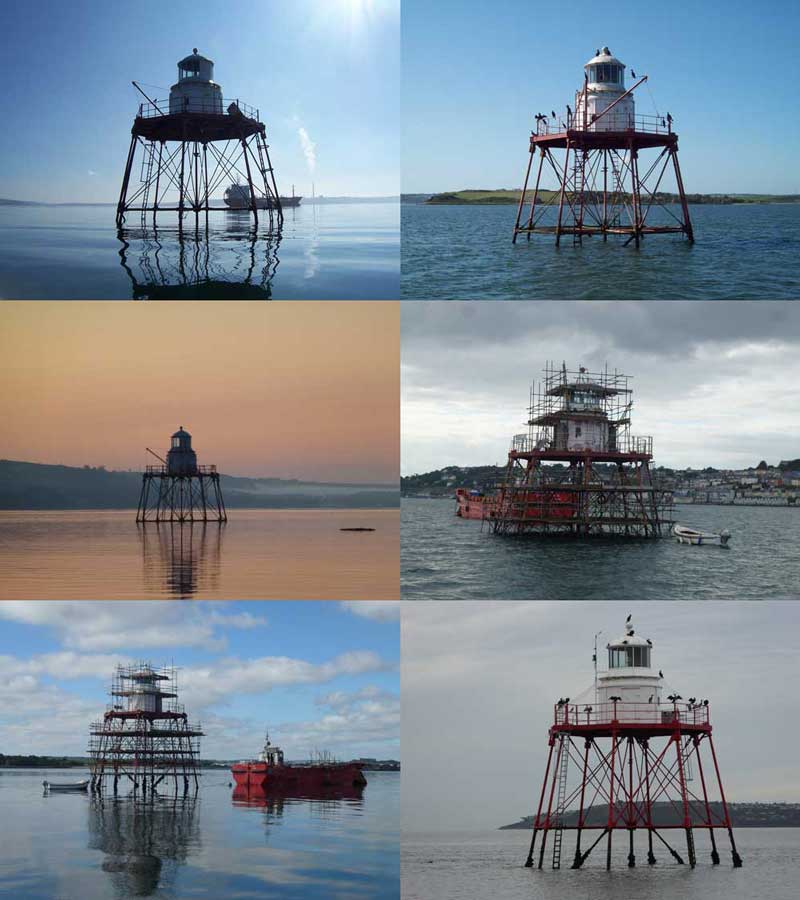

This particular Spit Bank is in Cork Harbour, Ireland. It is a naturally occurring, shallow section of mud and fine sand, east of Haulbowline Island, and opposite the town of Cobh (formerly known as Queenstown). The Spit Bank has been a hazard to shipping for centuries, as it lies in the path of any intended voyage to seaward or upriver to Cork. The bank is not generally visible in photographs and illustrations of the area, but parts of the bank are visible during spring tides.
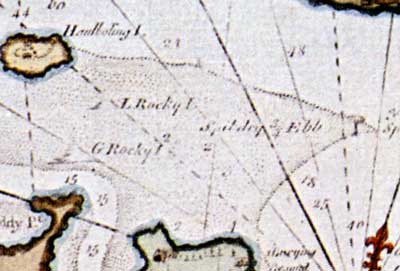
Rev Lindsay's chart of 1756, showing beacon on Spit Bank
Throughout history the depth of the bank appears to have been more or less constant, though earlier charts show the bank visible near low tide. Nature and dredging have effected little overall change on it. (There had been a channel cut through the bank until the 1930s')
The presence of this bank is not all negative, as it forms a natural breakwater, sheltering the town of Cobh from the worst of incoming seas generated by gales. It also has a long history of being utilised to beach disabled and sinking vessels for rudimentary repairs.
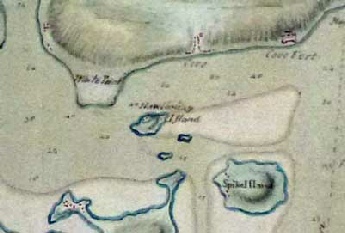
Chart from 1770 with mark on eastern edge barely showing
The shallow bank was also used as a careening location, where ships with badly fouled hulls would be intentionally run aground, heeled over, and would have the marine growth removed. Extra hazards on the Spit Bank are the occasional extra shallow sections created by heaps of ballast stones, removed from ships in the past, prior to loading cargoes.
In the mid 19th Century, overall responsibility for lighthouses in Ireland fell under the remit of the Ballast Board. The placing, maintenance and administration of buoyage within harbours depended mainly on local authorities. Cork, was a British naval station, The Admiralty had, since the late 18th Century, placed a number of buoys on local hazards such as the Harbour Rock, and Turbot Bank. The Reverend J. Lindsay's chart of Cork Harbour, in 1759, shows a beacon on the eastern edge of the Spit Bank. In fact there appears to have been two beacons marking the extremities of the bank in 1794. In 1805 another buoy was placed on the eastern edge of the Spit Bank.
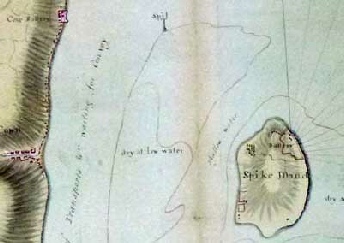
Lt Col Vallency's military map of 1781, showing beacon on bank.
From 1814, the newly-formed Cork Harbour Board, took on responsibility for buoyage and lights within Cork Harbour. This included the placing of another floating unlit buoy at the eastern end of the Spit Bank. This was regarded as completely unsatisfactory. In 1848 this buoy was replaced by a rudimentary light ship on the edge of the bank. This was simply a locally hired vessel, supporting a lamp. In 1850, the Ballast Board decided that a lighthouse on the Spit Bank was necessary. The Chief engineer of the Ballast Board, Robert Halpin, designed a revolutionary structure, utilising the patented screw-pile, designed by the blind Belfast engineer Alexander Mitchell. Mitchell himself won the contract, moved to the newly - named Queenstown, and work began on the lighthouse in 1851. The construction of the lighthouse has been well documented, with John Francis Maguire, MP and founder of the Cork Examiner newspaper, writing a comprehensive account of the saga.
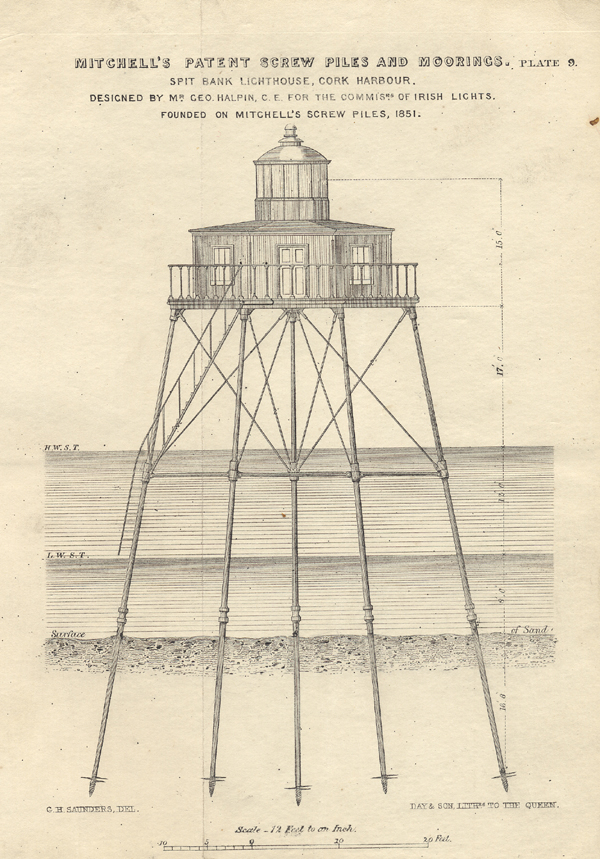
Plate of dimensions of the Spit Bank Lighthouse
The Spit Bank lighthouse became operational in March 1853. It was probably viewed by 19th century Cork inhabitants as an ugly utilitarian, industrial structure, and does not feature heavily in paintings and illustrations of the period. In November 1873, tragedy struck, when the assistant lightkeeper, Matthew Birmingham, lost his life. His accident occurred, while he was tending the lamp and fell down the iron stairs within.
The Spit Bank Light, was initially just a red lantern, guiding shipping away from the bank itself. In 1878 the light was sectored. This sectoring guided shipping away from the Bar Rock, another natural hazard in negotiating Cork Harbour (removed in the 1970’s). The light is still sectored.
The Spit lighthouse, while it was an marvellous innovative structure, had one major drawback. From the date of construction, it required regular maintenance, including expensive painting once a year. In 1894 a fog signal bell was added, but by the 20th century, questions were being asked about the necessity of this lighthouse.
Chart by Pickernell, in 1794, clearly showing two beacons on bank
In 1928 The Commissioners of Irish Lights, successors to the Ballast Board, wanted to remove the Spit Bank lighthouse. It was felt that a lighted buoy would provide the same level of cover as this expensive structure.
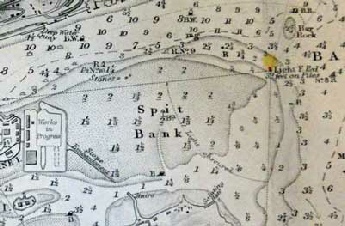
Admiralty chart of 1883 showing Spit Bank light, no sectors.
The manning of the lighthouse was another contentious issue for the Commissioners. There was no accommodation on the structure itself. It required the services of a shore-based principal keeper and assistant, to maintain the light. In 1938 the Harbour Commissioner s were approached by the Irish Lights, to facilitate the automation of the lighthouse. This was not accomplished until 1955, when the Spit finally became unmanned.
The lighthouse did remain under the control of the Commissioners, though in the 1960’s the question of abolishing the light was raised again. In 1985 Cork Harbour Commissioners (the Port of Cork Company since 1996) took over control of the Spit Bank Lighthouse from the Commissioners of Irish Lights.
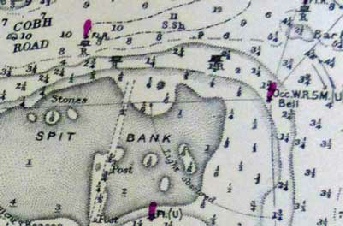
Admiralty chart of 1948, showing sectored light
In 2014 the lighthouse received a major refit, including the fitting of anti-bird netting. It has survived over 160 years of winter gales, and collisions with commercial shipping and pleasure craft.The Spit Light forms the boundary for compulsory pilotage, for vessels heading upriver to Cobh, Ringaskiddy, Rushbrook, Passage West, Marino Point, Tivoli, and Cork City
The Spit Bank lighthouse remains an iconic, photogenic, focal point in Cork Harbour. The necessity of this structure in an era of Radar and GPS is in some doubt, but it is an integral part of Cork’s maritime history.
